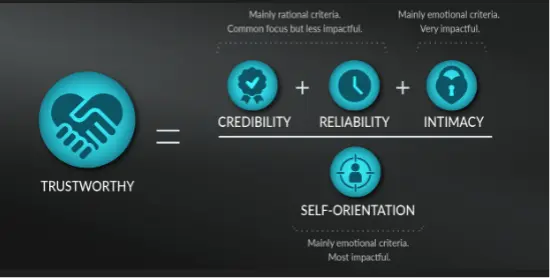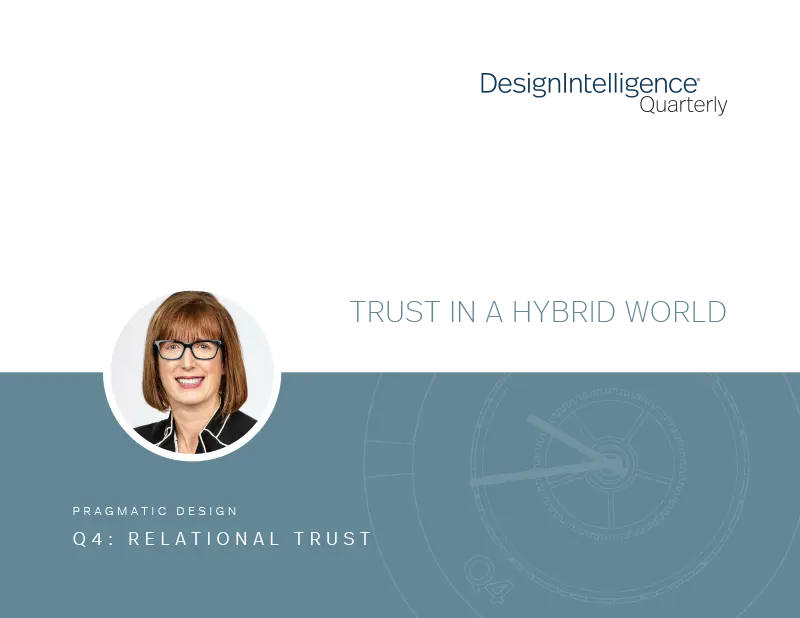Trust in a Hybrid World
by Michelle Perry
Chief Human Resources Officer (CHRO), Walter P Moore
December 6, 2023
Michelle Perry examines organizational trust in the post-COVID workplace.
Few of us were prepared for the changes in how our organizations do business since the COVID-19 pandemic. The ways in which we work, build relationships and connect are no longer straightforward or predictable. To adapt strategically, at Walter P Moore we have adopted a hybrid model that incorporates the best aspects of working from home and in our offices. As an example, working in a hybrid model helps us be more efficient by reducing commute times and working smarter. Beyond efficiency, it can also increase employee engagement by improving work/life integration. But it can also present obstacles in onboarding and mentoring of employees and in ensuring we foster a true connection to each other and our culture. While such connections are difficult even when we are in the office — particularly for introspective types — working in a hybrid model can present added wrinkles because connections and interactions may be easier to miss.
For context, operating in a hybrid model at Walter P Moore means combining working in the office and working remotely. It requires intelligent location choices each day that will provide the best working environment and situation. Going to be on virtual calls all day? Then working remote likely makes the most sense. Will you be collaborating on a multidisciplinary project, or are you onboarding a new employee? If so, then working in the office might be the best choice.
Trust is key to success in a hybrid environment. One of the concepts we deploy in learning and training is the Trust Equation.1 This equation considers:
- Credibility (technical knowledge and competence).
- Reliability (do what you say you are going to do).
- Intimacy (building a safe and authentic relationship).
- Self-orientation (the person’s focus — self-oriented or putting the other party first).
All these aspects factor into assessing trust levels. For engineers, the attributes of credibility and reliability are usually relatively simple. But for technical professionals, characteristics such as intimacy and self-orientation — with their more emotional/relational content — are more personal in nature and require greater focus in a hybrid work environment.
Why is trust so important? According to Gallup’s 2023 “State of the Global Workplace” report, employees who strongly agree that they trust the leadership of their organization are 7.7 times as likely to feel connected to their organization’s culture and 58% less likely to be actively looking for another job. Equally important, if not more so, trust is a foundational element in our client relationships.
 Diagram courtesy HKS
Diagram courtesy HKS
Trust Considerations
Here are some considerations to ensure that strong connections and trusted advisor relationships are being built both inside and outside your organization.
Soft Skills Training
Invest in soft skills training at all levels in your organization. In my organization, it starts from the top in our vision, which specifically mentions learning. Have a budget targeted to provide training on things such as communication skills, supervisory skills, leadership development, self-awareness, trust, etc. As an example, we target providing 20 hours of training per employee per year. Make it visible — I include progress on this goal to our board of directors.
Trust, But Verify
Long a personal mantra, it’s increasingly apropos in a hybrid environment. Trust your employees until they give you a reason not to. However, be thoughtful about how much “rope” you give them. Don’t just assume everything is going smoothly and the outputs will meet your expectations. If the employee is new or working on a task that is new for them, check in often on their progress, help eliminate roadblocks and provide clarity to earn — and teach — trust. If it’s a task they have proven proficiency in, it shouldn’t require as much oversight.
Manager Training
Gallup’s 2023 report also showed that 57% of managers are not given training on how to work and manage more effectively in a hybrid work environment. Many managers went from predominantly supervising everyone in the office to overseeing a staff that became fully remote during the pandemic to current blended approaches. These new modes require managers to be purposeful in how they manage and connect with their employees. Strong connections and relationships are now less likely to happen organically. To overcome these new hurdles, give managers the tools, resources and encouragement they need to be successful in hybrid work environments.
Be Aware of Proximity Bias
This is a danger managers need to be aware of. Don’t assume the person you may interact with more in person has greater skills than the person who works more days remotely. Measure the competency and performance of both types equally, objectively, situationally and fairly.

Building Connection
Zoom fatigue is real. While videoconferencing can be a great vehicle for meetings, it should also not completely replace certain in-person interactions and collaborations. Make it a point to hold some team meetings in person, do some team building activities, get to know one another and have fun! This is especially true for new hires. You want them to build strong connections with their team, their supervisors and the overall company culture. This will not happen by osmosis, and managers should have a purposeful plan on how to ensure that these relationship-building opportunities happen.
Explicit Goals/Measurement & Accountability
When you are not working side-by-side every day, it becomes even more important to have explicit goals that are fully understood by all. What does success look like? How will their performance be measured? The next key is to have consistent check-ins to measure progress and give feedback. Hold employees accountable in both directions. And, as a supervisor, give your team “permission” to hold you accountable. Are they getting enough of your time/attention? If not, encourage them to raise their hands.
Career Paths
Some engineers do not thrive on the client interaction/relationship-building part of their career. They would prefer to spend more time as technical gurus on the analytical side and thus remain valuable parts of the team. We reflect this in our career paths. Some paths include client relationships and others are more purely technical. Encourage people to focus on using their strengths.
The Trust Imperative
In today’s competitive marketplace, cultivating and maintaining trust is imperative in attracting and retaining employees as well as in winning and executing work. How you aim to build trust in all aspects of your business should be an integral part of your business-, client- and employee-engagement plans.
Ask yourself how you’re doing at focusing on the intimacy and self-orientation pieces of the trust equation. It may not be your natural tendency, but if you can build the aspirational plan, work the plan and measure your progress — for yourself, your teams and your organization — you’ll be miles ahead.
Michelle Perry is the chief human resources officer (CHRO) for Walter P Moore. She is a hands-on, service-focused human resources executive with a consultative, creative approach to solving business and HR issues. With over 25 years’ experience in the AEC industry, she leads the firm’s full spectrum of human resources including talent strategy, change management, employee engagement and cultural enhancement, employee relations, performance management, coaching, training and leadership development and compensation. Michelle lives in Houston, Texas, with her husband and four dogs.
FOOTNOTES:
1 The Trust Equation is a concept introduced by David Maister in his book, “The Trusted Advisor.”


